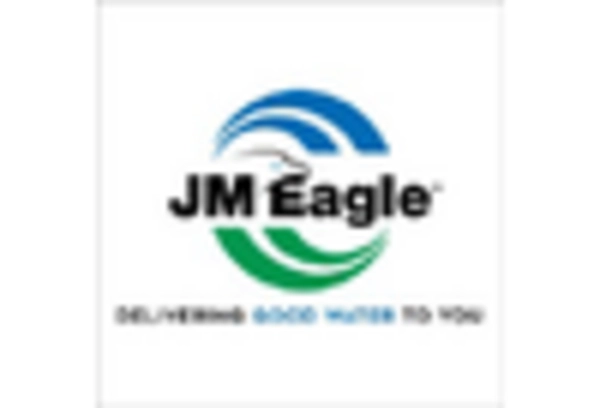Growth in Agricultural Applications
The agricultural sector's reliance on efficient irrigation systems is a notable driver for the HDPE Pipes Market. With the increasing need for sustainable farming practices, HDPE pipes are being utilized for drip and sprinkler irrigation systems. These pipes provide a cost-effective solution for water management, ensuring optimal water usage and reducing wastage. Recent statistics indicate that the agricultural sector is investing heavily in modern irrigation technologies, with a significant portion allocated to HDPE piping systems. This trend is likely to continue as farmers seek to enhance crop yields while conserving water resources. Additionally, the lightweight nature of HDPE pipes facilitates easy installation and maintenance, further encouraging their adoption in agricultural applications. Consequently, the growth in agricultural applications is poised to significantly impact the HDPE Pipes Market.
Infrastructure Development Initiatives
Infrastructure development initiatives are a critical driver of the HDPE Pipes Market. Governments and private sectors are increasingly investing in infrastructure projects, including transportation, utilities, and housing. The construction of new roads, bridges, and residential areas necessitates the use of reliable piping systems for water, sewage, and drainage. HDPE pipes are particularly suited for these applications due to their flexibility, strength, and resistance to environmental stress. Recent reports suggest that infrastructure spending is expected to rise, with a focus on sustainable materials and technologies. This shift is likely to enhance the demand for HDPE pipes, as they align with the goals of modern infrastructure projects. As such, the ongoing infrastructure development initiatives are anticipated to drive growth in the HDPE Pipes Market.
Rising Demand for Water Supply Systems
The increasing demand for efficient water supply systems is a primary driver of the HDPE Pipes Market. As urban populations grow, the need for reliable and durable piping solutions becomes paramount. HDPE pipes, known for their corrosion resistance and longevity, are increasingly favored for water distribution networks. According to recent data, the water supply sector is projected to expand significantly, with investments in infrastructure reaching unprecedented levels. This trend is likely to bolster the HDPE Pipes Market, as municipalities and private entities seek to upgrade aging systems and implement new projects. Furthermore, the emphasis on reducing water loss through leakage is driving the adoption of HDPE pipes, which offer superior sealing capabilities compared to traditional materials. Thus, the rising demand for water supply systems is expected to propel the HDPE Pipes Market forward.
Environmental Regulations and Standards
The implementation of stringent environmental regulations and standards is increasingly influencing the HDPE Pipes Market. Governments worldwide are enacting policies aimed at reducing environmental impact, particularly in the construction and utilities sectors. HDPE pipes, being recyclable and less harmful to the environment compared to traditional materials, are gaining traction as a preferred choice. Compliance with these regulations is becoming essential for companies involved in construction and infrastructure development. Recent data indicates that the market for eco-friendly materials is expanding, with HDPE pipes positioned favorably due to their sustainability attributes. This regulatory landscape is likely to encourage more industries to adopt HDPE piping solutions, thereby propelling the growth of the HDPE Pipes Market. The alignment of HDPE pipes with environmental standards is expected to be a significant factor in their market expansion.
Technological Innovations in Pipe Manufacturing
Technological innovations in pipe manufacturing are playing a pivotal role in shaping the HDPE Pipes Market. Advances in production techniques, such as extrusion and molding, have led to the development of high-performance HDPE pipes that meet diverse application needs. These innovations enhance the durability, flexibility, and overall performance of HDPE pipes, making them suitable for a wide range of uses, from municipal water systems to industrial applications. Recent trends indicate that manufacturers are increasingly investing in research and development to improve product quality and reduce production costs. This focus on innovation is likely to drive competition within the HDPE Pipes Market, as companies strive to offer superior products. As a result, the ongoing technological advancements in pipe manufacturing are expected to significantly influence the growth trajectory of the HDPE Pipes Market.


















Leave a Comment